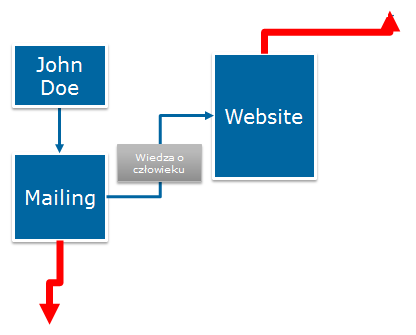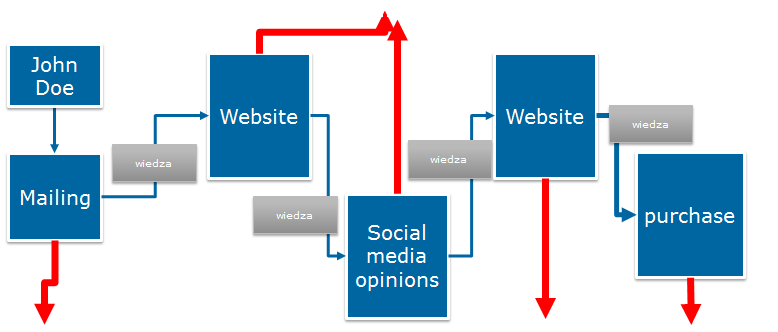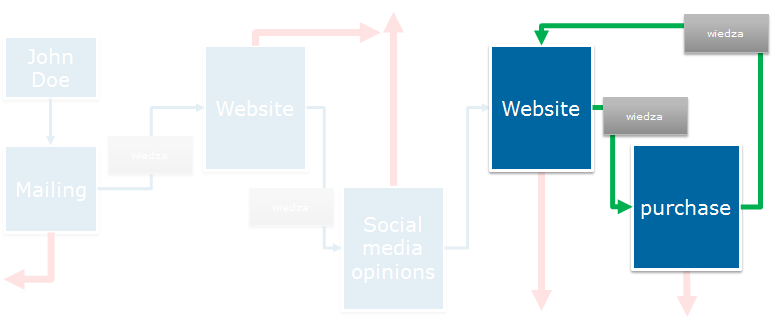Numbers are the answer! Atos Poland GDC

CareersinPoland.com

related articles
Starting with simple (are you sure it’s simple?) ROI calculations, through community building, daily communication with customers or prospects, ending up with proving to your boss your activities make sense – all of these are going to be just a number in one, big, all-encompassing tabular file.
Numbers are the knowledge…
… and to have knowledge means to have control – thank you, Captain Obvious – would be hard to find more evident statement. OK – data has been collected, processed, and at the end of the day (after achieving marketing KPIs) all Excell cells are green – but what is the conclusion? The right question at this point would be: “Does it really have an impact on our business?”
For the purpose of answering this question, let’s discuss a particular example:
Context:
A Bus operator, one of many in the country. Financials aren’t bad, despite the growing competition from both other operators and trains, as well as air transport (so called “low cost airlines”). The Board got the feeling the company is losing contact with its customers. They have struggles with customer identification; they cannot differentiate between loyal and one-time customers. It’s getting problematic to recognize the customer journey – and as a consequence, to identify crucial touchpoints?
Why gather information?
Information, can be transformed into knowledge – which can be translated into solutions to improve overall performance. Briefly: Business intelligence.
Let’s assume our company, basing on experience, plans to generate 100,000 marketing leads. Proper usage of data we gather about the customers – who they are, what they’re interested in, what websites they visit, what places they saw and what are their holiday plans – can significantly increase the number of leads: up to 20%[1], which brings us 120,000 marketing leads. Contact details to people potentially interested in giving us their money!
Go further. Let’s say, our company operates in the UK. Using current models and methods, from assumed 100K leads, the conversion rate (equal 4.59%[2] in the field of transportation e-commerce) would result in more less 4,6K customers. However, by proper usage of knowledge about those people, our company could increase the conversion rate by 51.5% - and as a result generate nearly 7 thousands new leads.
More leads, higher conversion rate – but at what cost? See the statistics – the average cost of generating 1 lead (from those assumed 100K) equals $22[3] (transportation e-commerce). Proper usage of data about the customers can possibly decrease cost of the lead by 13%[4] - which results in a $19.14 CPL (cost per lead).
Taking the above into consideration, let’s do some math:
In the current model, by spending $2.2mil the company would generate 4,590 customers, which ends with $479.3 per customer.
In the model based on knowledge and usage of it, company by spending circa $2.3mil can generate 8,340 customers (more leads, higher conversion rate), which results in 275.39$ per cusotmer (lower CPL).
Implementation of the solutions based on collection and usage of data about customers can significantly decrease cost of one customer – by 42.54%!
How to achieve it?
The main question of course is – what precisely do we understand by usage of the data about customers, especially in the context of the discussion about personal data security and methods of gathering and processing it by companies around the world.
Our hypothetical company doesn’t operate in vain. There are plenty of areas where the interactions between a company and potential customers take places. Website, social media, email, landing pages, SEO, SEM, e-commerce platforms – to mention the most recognizable. Those identified touchpoints generate enormous amount of data, and not only those obvious like first name, last name or personal data required to make a purchase. There is also additional information – what is the source of the traffic on our website, time spent on the website, visited subpages, does the visitor read the company’s blog, is the customer active on social media, what are interesting destinations for particular potential customers, does the customer prefer low-budget transportation… And this is only the tip of the iceberg of information we can gather through the above mentioned touchpoints. Why? To help our customer – even without identifying them – and give them a tailored offer.

To visualize the process, let’s take an example:
Our customer, John Doe, receives an initial mailing. For the purpose of this example, it’s enough to say we have his consent to receive information and to process his data – and the company doesn’t violate any legal regulations. If John Doe receives another ordinary mail, there is a huge chance he won’t even open it - just like 80% of other recipients[5]
 However, if the mail is personalised, based on gathered data about John (e.g. his searches of hotels in a particular city), and we title the mail suggesting a suitable transport to this place – the chance he will not only open the mail, but will most likely go further in the customer journey.
However, if the mail is personalised, based on gathered data about John (e.g. his searches of hotels in a particular city), and we title the mail suggesting a suitable transport to this place – the chance he will not only open the mail, but will most likely go further in the customer journey.
But, there is no point in redirecting John to our website if we can’t instantly present him the content that meets his needs in the first place! We must know what John is looking for (what concrete mail redirected him to the website) so we could display the proper content.
 The company is well known, but obviously not everyone has to recognize the name and scope of services – and definitely not everyone has to know our standards and our pride of them. If John Doe is a person who does not possess that information, in all likelihood he will look for opinions about our company – and what is better way to do it if not asking friends and peers?[6]
The company is well known, but obviously not everyone has to recognize the name and scope of services – and definitely not everyone has to know our standards and our pride of them. If John Doe is a person who does not possess that information, in all likelihood he will look for opinions about our company – and what is better way to do it if not asking friends and peers?[6]

Being conscious of the above, we can – by predicting the intentions of our potential customer – redirect him to the right space – no matter if it’s either opinions displayed on our website, profiles in social media or comments in search engines.
John Doe, having a certain destination, having the offer that meets his expectations AND needs, has read opinions about our company and has returned to our website. He has no intention to search the details of a particular trip once more, so we need to make sure he will receive his information instantly.
Is this the end?
Obviously not! We can get even more from those interactions. Firstly, if for any reason John resigns at any point of customer journey, we would have this information – and we can try to identify the reason.
Secondly – and this is the path we want to implement as a standard, just like any other transportation company – John Doe might convert into a loyal customer, who will consider our company in his future travel plans.

Some factors cannot be influenced. For example, as a marketing department, we cannot create his experience from the trip itself. Possibly he won’t like something during the trip – but of course we should do our best to collect additional data to utilise, e.g. for addressing the issues and working on improving the overall performance of the company.
How to put this all together?
Marketing automation – this might be the answer.
System that enables company to not only aggregate data from various touchpoints, but also use them for actual activities. CRM integration, social media management, mailing system, CMS for websites and landing pages – and limitless areas and dimensions for data analysis. And – these are just examples of capabilities of Marketing Automation solutions.
That’s why, when it comes to strategic decision making, creative ideas are appreciated, but decisions are made (or at least should be) based on actual numbers.
[1] DemandGen, Calculating the Real ROI from Lead Nurturing, 2013
[2] Monatate Ecommerca Quarterly Report [Q4 2015, Q1-Q3 2016]
[3] State of Inbound Marketing Report, 2013
[4] State of Inbound Marketing Report, 2013
[5] mailchimp.com/resources/research/email-marketing-benchmarks
[6] PwC, "They say they want a revolution: Total Retail 2016”
Our expert:
 Andrzej Okrasa
Andrzej Okrasa
Senior Digital Transformation Consultant at Atos Global Delivery Center Poland
Open-minded digital marketing consultant with strong technical background.
I have 6+ years of experience gathered in various branches, helping organisations on different levels of their Digital Journey. My professional interests cover Marketing Automation (Hubspot Certificates: E-mail marketing, Content Marketing, Inbound Sales) and analytics (Google Analytics Individual Certification). My academic background - Sociology: social communication - helps me to see things from a different angle, better understand customer's journey, define challenges and translate them into recommendations for future activities - and, at the end, execute.
I like to spend my free time with my fiance and our two dogs - silly but adorable english cocker spaniels. And books - I couldn't live without at least one new book per week.












